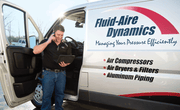If you have compressed air in your facility, you may also need compressed air dryers.
Compressed air systems will always produce moisture. If the pressure dew point is reached, the water vapor will condense into water and can impact your productivity and equipment. An air dryer eliminates the moisture your compressor produces so that you can have pure, clean compressed air for your facility. If you’re using compressed air systems, it’s likely you need a dryer for your air compressor. But how do you know if you need this equipment, and how does it work?
Let’s learn more about air dryers, what types exist and how they help remove moisture from your compressed air systems.
In This Article
- What Is an Air Dryer?
- The Purpose of Air Dryers
- Why Are Air Dryers Important?
- How Do Air Dryers Work?
- Contact Fluid-Aire Dynamics for High-Quality Air Dryers and Air Dryer-Related Products Today
What Is an Air Dryer?
An air dryer is a piece of equipment or a drying system that removes moisture from the air. Compressed air drying systems or equipment are essential for facilities with a compressed air system since compressed air increases a space’s relative humidity.
Air dryers work in different ways, depending on the system you have. However, they all draw moisture out of the air so that vapor does not condense and your system can continue running at maximum efficiency. Air dryers use adsorption, filtration, absorption, refrigeration and diffusion to eliminate excess moisture from the air.
The Purpose of Air Dryers
Air dryers suppress the dew point of your compressed air by removing water from it. Compressed air often contains moisture, which can reach the dew point temperature under the right conditions. Once this dew point is reached and excess moisture forms, it can lead to water vapor condensing, allowing moisture to build up in the system and damage equipment. This can create significant problems, such as leading to corrosion, causing frozen pipes and contaminating your products or equipment.
Why Are Air Dryers Important?
Air dryers are essential for well-functioning air compressor systems. Moisture is inevitable with air compression — it’s a natural byproduct of the system, and without removal, your facility will soon gave a moisture problem. Here are some of the advantages you can expect when you add an air dryer to your compression system:
- Prevents freezing: If vapor condenses into water, the water can freeze in the face of low temperatures. Freezing can lead to jams in moving components. It can also accumulate on process lines and interfere with process or product fluid movement.
- Removes contamination: Contamination is a serious danger for industries using high-purity compressed air. Areas like plasma generation, food and pharmaceutical products manufacturing, laser cutting and welding, painting, coating and shot blasting all require pure compressed air to function. If water builds up, efficiency decreases, productivity slows or products get damaged.
- Halts water buildup: Water will build up in small pockets within downstream equipment without moisture removal. Too much buildup can cause sensitive equipment to perform inaccurately, harming production quality and output.
- Reduces microbial growth: The pharmaceutical and food and beverage industries use compressed air to mix and convey product. Water is prone to bacteria growth, and any water in your condensed air system can quickly lead to food and beverage spoilage or contamination. Additionally, small amounts of microbes in pharmaceutical plant products can result in entire batches being thrown out to avoid health risks.
- Improves efficiency: If your facility uses air-powered equipment and tools powered by energy from compressed air systems, water will reduce its efficiency. It can damage internal components and reduce the power delivered, impacting production.
- Inhibits corrosion: Water is excellent at corroding steel. Components like pipes, drums, vessels and tanks are typically made from steel and will begin to break down when moisture buildup turns to water and corrosion. When corrosion forms, process and product streams can quickly become contaminated.
How Do Air Dryers Work?
At the most basic level, air dryers separate moisture from industrial process air. Moisture is inherent to compressed air, so the air dryer must take that air and remove the excess moisture from it. This is done through diffusion, absorption, filtration or refrigeration. Each method sends compressed air through the system, drawing out the water so that the system can function efficiently and without damage.
The action of your air dryer and the way it protects your compressed air from excess moisture will vary depending on the type of air dryer you use. The standard types of dryers we use with compressed air systems include:
- Refrigerated Dryers: The most common type of air dryer you will see in an industrial compressed air system is the refrigerated dryer. These work by a simple mechanism of using one or more heat exchangers to cool down the hot compressed air, condense out the bulk of the water and remove the water through a separator equipped with an automatic drain. If you are looking for a reasonably-priced dryer and do not need unusually high drying capabilities, these are often the best and most economical choice.
- Desiccant Dryers: If you are in an extreme situation where your air is subject to very low temperatures or your products or environment cannot tolerate any moisture at all, a desiccant dryer may better serve you. These dryers use a material such as activated alumina to absorb water from the compressed air. Desiccant dryers come in a wide variety of types, such as heated, heatless or blower purge models.
- Specialty Gas and Liquid Dryers: Water is not the only moisture-related contaminant that could impact your facility. Many industries work with gases or liquids that might interfere with production. If your company works with exotic or dangerous gases or liquids that need drying, such as benzene, butane, hydrogen or landfill gas, there are specialty dryers designed to safely remove moisture from these products. They work similarly to air dryers but focus on their specific gas or liquid removal instead of just water.
- Membrane Dryers: Membrane dryers are very efficient dryers that dehumidify and depress the dew point as the air comes into the system. These dryers have a permeable membrane that allows water vapor to pass through. The membrane catches the water vapor, lowering the dew point temperature so condensation cannot occur. They are becoming increasingly popular as they require no electricity, have a low-installation cost, are easy to maintain and perform quietly.
- Deliquescent Dryers: Deliquescent dryers are another brand of electricity-free, economical air dryers. They work using a pressure vessel containing dissolving salt tablets that absorb water vapor. Compressed air runs through the dryer, and the salt pulls all the water out. The salt dissolves with the water, turning into a brine that collects in a special tank. Meanwhile, the air passes out through the system moisture-free.
Contact Fluid-Aire Dynamics for High-Quality Air Dryers and Air Dryer-Related Products Today
Fluid-Aire Dynamics, a leader in compressed air systems, has a wide variety of highly effective air dryers of all different types for you to choose from. We are located in Pennsylvania, but we also offer preventative maintenance and emergency service to areas in Delaware, Maryland, Northern Virginia, Southern New York and New Jersey . To find the one that’s right for you or to get a free estimate on one of our air dryers for your business, contact us now.




